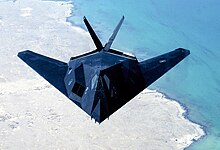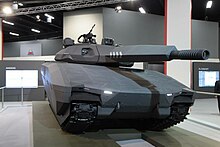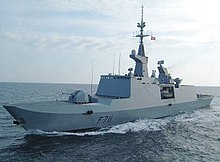
Back تقنية التخفي Arabic Teunoloxía furtiva AST Stels texnologiyası Azerbaijani Стэлс Byelorussian Стелт (технология) Bulgarian স্টেলথ প্রযুক্তি Bengali/Bangla Tecnologia furtiva Catalan Stealth Czech Stealth-teknologi Danish Tarnkappentechnik German



Stealth technology, also termed low observable technology (LO technology), is a sub-discipline of military tactics and passive and active electronic countermeasures,[1] which covers a range of methods used to make personnel, aircraft, ships, submarines, missiles, satellites, and ground vehicles less visible (ideally invisible) to radar, infrared,[2] sonar and other detection methods. It corresponds to military camouflage for these parts of the electromagnetic spectrum (i.e., multi-spectral camouflage).
Development of modern stealth technologies in the United States began in 1958,[3][4] where earlier attempts to prevent radar tracking of its U-2 spy planes during the Cold War by the Soviet Union had been unsuccessful.[5] Designers turned to developing a specific shape for planes that tended to reduce detection by redirecting electromagnetic radiation waves from radars.[6] Radiation-absorbent material was also tested and made to reduce or block radar signals that reflect off the surfaces of aircraft. Such changes to shape and surface composition comprise stealth technology as currently used on the Northrop Grumman B-2 Spirit "Stealth Bomber".[4]
The concept of stealth is to operate or hide while giving enemy forces no indication as to the presence of friendly forces. This concept was first explored through camouflage to make an object's appearance blend into the visual background. As the potency of detection and interception technologies (radar, infrared search and tracking, surface-to-air missiles, etc.) have increased, so too has the extent to which the design and operation of military personnel and vehicles have been affected in response. Some military uniforms are treated with chemicals to reduce their infrared signature. A modern stealth vehicle is designed from the outset to have a chosen spectral signature. The degree of stealth embodied in a given design is chosen according to the projected threats of detection.
- ^ Rao, G.A.; Mahulikar, S.P. (2002). "Integrated review of stealth technology and its role in airpower". Aeronautical Journal. 106 (1066): 629–641. doi:10.1017/S0001924000011702. S2CID 108545502.
- ^ Mahulikar, S.P.; Sonawane, H.R.; Rao, G.A. (2007). "Infrared signature studies of aerospace vehicles". Progress in Aerospace Sciences. 43 (7–8): 218–245. Bibcode:2007PrAeS..43..218M. doi:10.1016/j.paerosci.2007.06.002.
- ^ Richelson, J.T. (10 September 2001). "Science, Technology and the CIA". The National Security Archive. The George Washington University. Retrieved 6 October 2009.
- ^ a b Merlin, Peter W. (5–8 January 2009). Design and Development of the Blackbird: Challenges and Lessons Learned (PDF). 47th AIAA Aerospace Sciences Meeting Including The New Horizons Forum and Aerospace Exposition. Orlando, Florida: American Institute of Aeronautics and Astronautics. Archived from the original (PDF) on 18 October 2013. Retrieved 6 October 2009.
- ^ Cadirci, S. "RF Stealth (or Low Observable) and Counter- RF Stealth Technologies: Implications of Counter- RF Stealth Solutions for Turkish Air Force Archived 2011-07-20 at the Wayback Machine." Naval Postgraduate School, Monterey California, PhD Thesis. March 2009. Retrieved 6 October 2009.
- ^ Yue, T. (30 November 2001). "Detection of the B-2 Stealth Bomber and a Brief History on "Stealth"". The Tech – Online Edition. Massachusetts Institute of Technology. Retrieved 5 October 2009.
© MMXXIII Rich X Search. We shall prevail. All rights reserved. Rich X Search